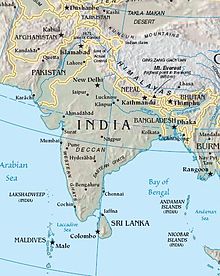| Revision as of 17:12, 11 April 2004 view source140.247.71.217 (talk)No edit summary← Previous edit | Revision as of 00:25, 9 May 2004 view source Cantus (talk | contribs)21,464 editsNo edit summaryNext edit → | ||
| Line 1: | Line 1: | ||
| ] | |||
| ⚫ | '''South |
||
| with the northern part of Afghanistan placed in ]. | |||
| ⚫ | '''South Asia''' is a subregion of ] comprising the modern states of ], ], ], ], ], ], and the ]. It covers about 4,480,000 km<sup>2</sup>, or 10 percent of the continent. | ||
| It includes the region sometimes called the ]. It contains well over a fifth of the ]'s ]. | |||
| South Asia ranks among the ]'s most crowded places. About 1 1/3 billion people live there—about a third of all ]s and a fifth of all the people in the world. The region's population density of 305 persons per km<sup>2</sup> is more than 7 times the world average. | |||
| ⚫ | |||
| ⚫ | The region has a long history. Ancient civilisations have sprung up from the ] Valley. The region was at its most prosperous before the 17th century; ] lead to the conquering of the region, which began to fall apart in the feud between ], ], ] and ]. With the post-colonial period of the ], the region was partitioned into ] and the two ]s, one of which became ]; ] gained independence from India. | ||
| ⚫ | :''See also: ]'' | ||
| <br clear="all"> | |||
| ⚫ | See also: ] | ||
| <br><br><br><br><br> | |||
| ---- | ---- | ||
| ⚫ | '''Southern Asia''' sometimes refers to all of Asia that was not part of the ]. | ||
| ⚫ | '''Southern Asia''' sometimes refers to all of Asia that was not part of the ]. | ||
| {{msg:South_Asia}} | |||
| ] |
] | ||
| ] | |||
| ] | |||
Revision as of 00:25, 9 May 2004

South Asia is a subregion of Asia comprising the modern states of India, Pakistan, Bangladesh, Sri Lanka, Nepal, Bhutan, and the Maldives. It covers about 4,480,000 km, or 10 percent of the continent.
South Asia ranks among the world's most crowded places. About 1 1/3 billion people live there—about a third of all Asians and a fifth of all the people in the world. The region's population density of 305 persons per km is more than 7 times the world average.
The region has a long history. Ancient civilisations have sprung up from the Indus Valley. The region was at its most prosperous before the 17th century; colonialism lead to the conquering of the region, which began to fall apart in the feud between Britain, France, Portugal and Holland. With the post-colonial period of the 20th century, the region was partitioned into India and the two Pakistans, one of which became Bangladesh; Bhutan gained independence from India.
- See also: History of South Asia
Southern Asia sometimes refers to all of Asia that was not part of the Soviet Union.